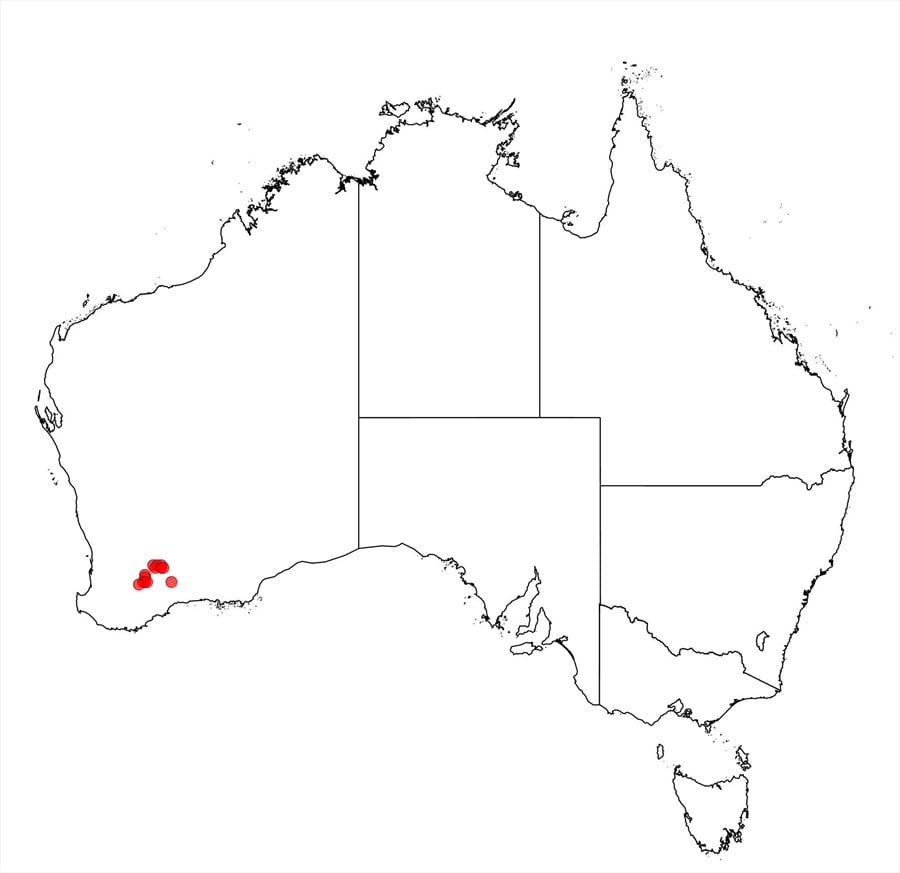Acacia obesa R.S.Cowan & Maslin
WATTLE
Acacias of Australia
Family
Fabaceae
Distribution
Occurs in a restricted area near Lake Grace, Hyden and Lake King, W.A.
Description
Spreading shrub mostly 0.3–0.6 m high. Branchlets terete, tomentulose, occasionally appressed-puberulous. Phyllodes mostly shallowly to strongly incurved but sometimes a few ±straight, terete, (1–) 1.5–2.5 cm long, 1.2–1.75 mm diam., rounded-obtuse, often minutely mucronulate, normally thick, usually glabrous, strongly striate by 12–16 fine, raised nerves. Inflorescences simple; heads sessile, globular, 3.5–4 mm diam., 9–14-flowered, light golden. Flowers 5-merous; sepals 2/3–3/4-united. Pods linear, strongly curved, becoming 1- or 2-coiled after dehiscence, biconvex, 2–4 cm long, 2–2.5 mm wide, coriaceous, glabrous except puberulous basally or generally puberulous. Seeds longitudinal, quadrate-rotund, 1.5–1.8 mm long, glossy, mottled shades of tan; aril nearly as long as seed.
Habitat
Grows in sand and gravelly loam, in low open woodland, open scrub and open heath.
Specimens
W.A.: 27 km N of Lake Grace towards Kulin, B.R.Maslin 4070 (PERTH); 1 km S of Lake King township, P.G.Wilson 6940 (NSW, PERTH).
Notes
Related to A. dielsii which is distinguished most readily by its pods and exarillate seeds, peduncles 2–4 mm long, branchlets commonly glabrous and phyllodes more slender. Also superficially similar to A. pinguiculosa subsp. teretifolia which has 6-nerved, weakly curved phyllodes, pedunculate heads and differently shaped, smaller seeds. Acacia arcuatilis also superficially resembles A. obesa but is readily distinguished by its 8-nerved phyllodes, 4-merous flowers and straight, narrower pods.
A variant from along the Kulin road north of Lake Grace (B.R.Maslin 4070, PERTH), has the phyllodes loosely tomentulose at first but glabrescent, and the pods generally puberulous; all the other collections have glabrous phyllodes except for the pulvini which have an indumentum as on the branchlets.
FOA Reference
Data derived from Flora of Australia Volumes 11A (2001), 11B (2001) and 12 (1998), products of ABRS, ©Commonwealth of Australia
Author
R.S.Cowan
Minor edits by J.Reid
This identification key and fact sheets are available as a mobile application:
URL: https://apps.lucidcentral.org/wattle/
© Copyright 2018. All rights reserved.







